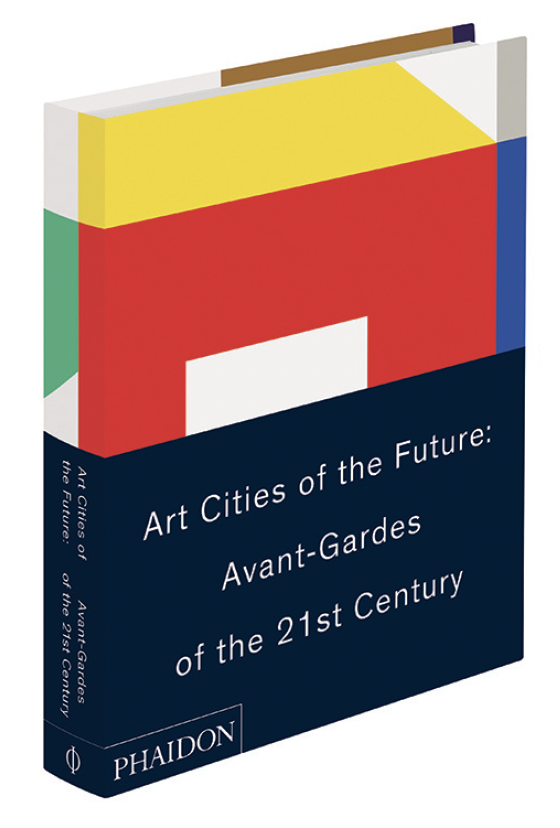“Art Cities of the Future: 21st-Century Avant-Gardes

Art Cities of the Future: Avant-Gardes of the 21st Century, 2013, book cover, Phaidon Press.
In recent years, Taschen Books has been bringing out an annual volume titled Art Now, a survey of 100 leading contemporary artists worldwide. Listed alphabetically, they are named, it seems, for both their accomplishments and their collectability. Some are long established, others have more recently “emerged,” but none of them really surprises the reader. Essentially, they are the known visual arts elite of the day, having commanded a hefty helping of critical, curatorial and commercial success. I mention Art Now because, although it is not the book under review here, it is the kind of survey that Art Cities of the Future: 21st-Century Avant-Gardes seems to position itself against.
A big, handsome, ambitious work from Phaidon—large format, 336 pages, over 550 colour images, and essays by a range of respected writers, critics and curators—Art Cities of the Future proposes a redrawing of the visual arts map. It identifies 12 far-flung and widely various urban centres that, it asserts, are changing the shape of the global visual arts dialogue. These formerly peripheral places are “poised to become art world hubs”—and they are as different in social, political, economic, historic, cultural and geographic conditions as Lagos, Nigeria and Cluj, Romania, as Johannesburg, Beirut, Singapore—and Vancouver. Consider, for instance, that Lagos has a population of 21 million while Cluj has a mere 305,600 inhabitants. Johannesburg is one of the most violent and crime-ridden places in the world while Singapore is (oppressively) peaceful and lawabiding. Vancouver is consistently named one the planet’s most livable cities while Beirut bears the scars of Lebanon’s 15-year civil war and is still the scene of assassinations and terrorist bombs. The other cities identified here are Bogotá, Delhi, Istanbul, San Juan (Puerto Rico), São Paulo and Seoul. Not named are London and New York, except to acknowledge their roles as “major marketplaces and distributional centres” for contemporary art. And while it doesn’t seem too likely that their status will diminish any time soon, we are nonetheless asked to consider the impacts of post-colonialism, globalization, digital communication and rapidly multiplying art fairs and biennials in altering the international visual arts landscape.
In the book’s preface, the editors write that they are reinventing the 100-best formula by “digging deeper…uncovering 12 distinct avant-gardes” around the world. Each of the 12 guest authors has been invited to write an introduction to his or her city and also to identify eight artists or art collectives to watch out for in the future. The 96 artists and collectives examined in Art Cities of the Future, the editors add, “all share two distinct qualities: a commitment to experimental art and a dedication to their local milieu.” Their work ranges from Charles Okereke’s large-scale colour photographs of discarded garbage and Donna Ong’s tabletop installation of small ceramic and cloisonné objects to Miler Lagos’s carved sheets of printed paper and Rebecca Brewer’s shaped paintings on felt. Most of the art reproduced here is wonderfully engaging, employing smart, post-modern strategies and materials. None of it is so outrageously ahead of its time that I personally would assign it a designation of “avant-garde”— but then that term has been contested for a few decades. (Richard Kostelanetz, author of Dictionary of the Avant-Gardes, writes that his “basic measures of avant-garde work are esthetic innovation and initial unacceptability”—although he doesn’t say to whom the art is unacceptable). Although the artists named are mostly young and not yet international powerhouses, they have already been vetted by the critical and curatorial mainstream. Vancouver-based Brewer, for instance, is an RBC Canadian Painting Competition winner.
In summing up the recent histories of these future art cities, the writers allude not only to mentoring and trendsetting senior artists but also galleries and gallerists, curators and critics, playwrights and poets, universities and art schools, project spaces and artist-run centres—all not only conducive but necessary to the evolution of a lively contemporary art scene. In some instances, specific trends and preferences emerge: media and performancebased art in Delhi, painting in Cluj, a fondness for botanical references in Bogota. Some of the cities named here have survived periods of violence and destruction, deprivation and isolation. In laid-back, bicycle-loving Vancouver, the major challenge seems to be upwardly spiralling real estate prices which, although hardly on a par with the slaughter of civilians by drug lords, paramilitary gangs and religious extremists, get a mention because of their impact on where and how artists live and work.
While it’s not news that Africa, Asia, Latin America and the Middle East have emerged in recent decades as vital players in the international art world, a few of the cities spotlighted in this book strike some of us as a tad arbitrary. Seoul and Singapore, yes, but not Shanghai? Bogotá and San Juan but not Havana? Cluj but not Warsaw? Really? Still, what struck me most is that the 21st-century art world projected here is no closer to gender equity than the 20th century’s was, even though the book’s 12 authors— the people making the choices of whose work to feature—are equally divided between male and female. By my tally, the artists surveyed number 65 men, 27 women, and four collectives. (Even within the collectives, the ratio is often twice as many men as women). Startlingly, all eight of the artists chosen to represent Cluj are men. Is that what the 21st-century avantgarde looks like? The most equitable representation of the sexes is found in Geeta Kapur’s Delhi and Duygu Demir’s Istanbul. Paradoxical, yes, but I’m happy to believe that these two places are indeed poised to become the art cities of the future. ❚
Art Cities of the Future: 21st-Century Avant-Gardes, Edited by Kari Rittenbach, with contributions by Antawan I. Byrd, Duygu Demir, Hyun Jung et al, Phaidon, 2013, 336 pages, $79.95.
Robin Laurence is a Vancouver-based writer, curator and Contributing Editor to Border Crossings.

